Workflow for Antibody and Fragment Analysis of Adalimumab (Humira)
Protocol for SEC-UV analysis of a monoclonal antibody aggregates and fragments
Jessie Zhixin Miao1, Linh Nguyen,2, Stephan Altmaier3, Katie Falls2, Uma Sreenivasan1
1MilliporeSigma, Round Rock, TX, USA, 2Sepax, Newark, DE, USA, 3Merck KGaA, Darmstadt, Germany

Preparation
Antibody Stressing
Chromatography
Measurement and Analysis
Table of Contents
ABSTRACT
A complete SEC-UV workflow has been developed to enable the analysis of antibody aggregates and fragments. This workflow offers the following:
- System suitability test utilizing a protein standard mix
- Procedures for pH and temperature stressing of antibodies
- SEC-UV method for antibody monomer, aggregates, and fragments separation/analysis
INTRODUCTION
Monoclonal antibodies (mAbs, or immunoglobulins - IgGs) are large glycoproteins with a molecular weight of approximately 150 kDa (150,000 g/mol). These biomolecules are composed of two light chains (LC, molecular weight ca. 25 kDa each) and two heavy chains (HC, molecular weight ca. 50 kDa each) linked through covalent inter- and intra-chain disulfide bonds. mAbs are utilized for the treatment of various types of cancer and other diseases such as multiple sclerosis, Alzheimer’s disease, and migraine.
Careful and thorough characterization of therapeutic mAbs is essential for ensuring drug safety and efficacy. mAbs are typically manufactured in mammalian host cell lines in bioreactors, generating many heterogeneous drug molecules. Establishing several critical quality attributes (CQAs) for each mAb and demonstrating that production batches are within acceptable limits are requirements for both innovator and biosimilar therapeutics.1,2 In many cases, the characterization of an antibody-based drug is performed using a specific chromatographic technique (e.g., size exclusion, reversed phase or hydrophilic interaction liquid chromatography, respectively – SEC, RP or HILIC)3,4 coupled with UV or mass spectrometry (MS) detection. This combination allows for different types of analyses to be carried out, e.g., accurate mass measurement of aggregates,5 the intact mAb and subunits, fragment analysis, peptide mapping, and the determination of post-translational modifications such as glycosylation, oxidation, and deamidation. SEC is a frequently utilized method for the determination of mAb fragments and aggregates.
Monoclonal antibody formulations can undergo various degradation processes during production, formulation, transport and storage, leading to the formation of protein aggregates and fragments - impurities that are CQAs and that must stay within specific limits. Typically, the total amount of impurities (high and low molecular weight - HMW/LMW) is required to be below 5% and no individual peak area should exceed 1-2%. Usually, the concentration of aggregates in a mAb formulation is higher than the fragment concentration and ranges from 1-5%. Specific limits are validated based on holistic characterization data or on stability trends.
During aggregation, two or more mAb monomers form a stable complex, a process that is very difficult to reverse. This aggregation can be induced by electrostatic interactions, for example, leading to self-association of mAbs in concentrated formulations. Another pathway for aggregate formation is misfolding or (partial) unfolding of antibodies creating hydrophobic regions which subsequently bind to each other. Chemical reactions such as disulfide bonding of thiol groups can also form mAb aggregates. Depending on the process, reversible and irreversible covalent and non-covalent species of different sizes can be observed.
Factors influencing aggregation are, e.g., temperature, pH value, shear stress during shaking or stirring, or exposure to light or hydrophobic surfaces.6 Fragmentation of mAbs can be described as the chemically or enzymatically induced disruption of a covalent protein bond.7 In the same manner as aggregation, fragmentation is a CQA that needs to be monitored. An inactivation of a mAb by irreversible fragmentation reactions is most frequently caused by temperature, pH or mAb concentration or the presence of enzymes, metals or radicals.
The presence of aggregates or fragments in antibody formulations is considered a paramount issue, since they can cause effects such as decreased or increased activity, increased cytotoxicity and immunogenicity and decreased solubility of the drug.8 More specifically, side effects such as headache, shivers, anaphylactic reactions or renal failure have been observed9 as well as the development of an immune response by patients. In such a situation, the effectiveness of a drug is strongly reduced.10 Hence, it is essential to characterize mAb aggregate and fragment formation during drug formulation and to establish a suitable quality control process for these therapeutics.
The focus of this work is to analyze/quantitate a variety of mAbs and their aggregates and fragments. The forced pH and temperature stress study was conducted on a monoclonal antibody, and the resulting aggregates and fragments, as well as monomers, were separated/quantified utilizing SEC-UV analysis.
EXPERIMENTAL PROCEDURE
Reagent Preparation
- 150 mM Phosphate Buffer, pH 7.0(±0.02)
To prepare 1 L of buffer, 8.751 g sodium phosphate monobasic and 23.191 g sodium phosphate dibasic were added to 950 mL HPLC grade water. Sodium hydroxide solution (2 mol/L) was used to adjust the pH value. HPLC grade water was added to a 1 L graduated cylinder to make the final volume 1 L. The buffer was filtered through a 0.2 µm filter before use. - 150 mM Phosphate Buffer, pH 7.0 + 300 mM Sodium Chloride
To prepare 500 mL of salt buffer, 8.766 g sodium chloride was dissolved in 450 mL of 150 mM phosphate buffer.150 mM phosphate buffer was added to a 500 mL graduated cylinder to make the final volume 500 mL. The buffer was filtered through a 0.2 µm filter before use.
System Suitability Sample Preparation
- Protein Standard Mix (15-600 kDa) was used as a system suitability sample.
- Sample preparation/dilution: 1 mL of 150 mM phosphate buffer was added to the protein standard vial. The vial was gently swirled to dissolve the lyophilized protein mix powder. 10 µL of this reconstituted protein standard solution was injected onto the LC system.
Unstressed mAb Sample Preparation
Five mAb samples were prepared using the following protocols:
- Adalimumab (Humira) and Infliximab
Both adalimumab (A-166) and infliximab (I-042) were received as 0.25 mL sample solutions formulated in 12.5 mM histidine buffer with an initial concentration of 10 mg/mL. 2.25 mL of 150 mM phosphate buffer was added to the original vials to make the final mAb concentration 1 mg/mL. Samples were mixed thoroughly before injection onto the LC system.
- SILu™Lite SigmaMAb™
SILu™Lite SigmaMAb™ Adalimumab Monoclonal Antibody (MSQC16), SILu™Lite SigmaMAb™ Rituximab Monoclonal Antibody (MSQC17), and SILu™Lite SigmaMAb™ Cetuximab Monoclonal Antibody (MSQC18) were obtained as solid powders. 0.5 mL of 150 mM phosphate buffer was added into the sample vials and the vials were gently swirled to dissolve the solid powder.
Stressed mAb Sample Preparation
Adalimumab (Humira) solution was stressed following the procedures below:
1 M hydrochloric acid solution was added dropwise by a pipette to change the pH value of the adalimumab sample solution from 6.0 to 1.0. Then, 1 M sodium hydroxide was added to raise the pH value to 10.0. Finally, 1 M hydrochloric acid solution was utilized to adjust the pH to 6.0. There was approximately a 1 min wait/equilibration time between the pH shifts while the sample solution was constantly stirred at 500 rpm. Finally, the resulting sample solution was incubated in a water bath at 60 °C for 60 min.
SEC-UV SYSTEM SETUP AND DATA ANALYSIS
Instrument and System Setup
The essential settings of the SEC-UV chromatography system applied in the analysis of antibody aggregates and fragments are listed in Table 1 below.
1 Starting protocol: It is recommended to slowly ramp up the flow rate after installation. Then, the column is not exposed to a high pressure suddenly. For the column used in this study, the startup flow rate is 0.1 mL/min and ramp up at increments of 0.1 mL/min. Once the baseline is stable at each step, the next 0.1 mL/min increment was added until 1 mL/min was achieved. Once the baseline was stable at 1 mL/min, the sample injections were started.
2 Use three injections in case of new columns.
3 Repeat the blank x 1, sample x 2 injection sequence as more samples are needed. It is highly recommended that an injection of 6 M guanidine hydrochloride is performed for every eight hours of consecutive runs. Run sequence is not recommended to last longer than 24 hours.
4 After guanidine hydrochloride injection and before shutdown protocol, column should be in the neutral, low salt storage solution. A slow ramping down process is applied like the starting protocol.
Data Analysis
For quantitative analysis of aggregates (HMWs), monomers and fragments (LMWs), all sample peaks are not present in the blank were integrated. For automatic integration, the integration events below were used to integrate the peaks. For smaller peaks such as the LMW1 region that cannot be detected by integration events, manual integrations were applied.
Percentage of area for monomers and its HMW, LMW regions were then computed to characterize the purity of sample and understand the aggregation formation of the stressed sample.
COLUMN MAINTENANCE AND STORAGE
- Daily Preventative Care
To maximize the column lifetime, 100 µL of 6 M guanidine hydrochloride was injected onto the column at the end of the sample sequence before switching to the storage solution. Guanidine hydrochloride can help to gently remove lingering impurities or sample components out of the column. This procedure will prevent blockage of the column head leading to a large buildup of pressure or potentially damaging the column resin bed structure.
- Storage Solution
For short-term storage (up to 3 or 4 days), mobile phase is used for column storage after guanidine hydrochloride injection. In case of long-term storage, the column is best flushed with 50 mM phosphate buffer, pH 7.0 with 0.02% sodium azide. Before storing the column, the end fittings should be tightly sealed with the end plugs that came with the column to prevent the packing from drying.
RESULTS
Zenix® and Zenix®-C SEC columns are identical products except for the surface coating. Zenix® has a stand-up monolayer and Zenix®-C has a laydown monolayer. The laydown monolayer is specifically designed to alleviate secondary interactions for sticky or hydrophobic sample types getting adsorbed in traditional surface coatings. For highly charged, hydrophobic proteins, or derivatized mAbs with polymer branches, the Zenix®-C column will show a significant difference to the Zenix® column.
In this work, both Zenix® and Zenix®-C columns were used to characterize the mAb aggregates and fragments using SEC-UV analysis. The injection sequence showing in Table 2 was used for the sample analysis. Briefly, there were three steps in the data collection:
1) System suitability test
2) Unstressed sample test to characterize the mAb aggregates, fragments, and its monomer using SEC-UV
3) Stressed sample test to compare the aggregation of mAb under the force of pH and temperature
All of the data was collected at wavelengths of both 214 nm and 280 nm.
SYSTEM SUITABILITY TEST RESULTS
A volume of 10 µL of the protein standard mix 15-600 kDa was injected onto the SEC-UV system with the UV wavelength set at 280 nm. 150 mM of sodium phosphate buffer (pH 7.0) was used as mobile phase. Zenix® and Zenix®-C SEC columns were compared at a column temperature of 23 oC with the flow rate at 1.0 mL/min. A representative chromatogram is displayed in Figure 1a. The chromatogram shows the five peaks corresponding to the five components in the standard mix based on the molecular size order thyroglobulin, bovine γ-globulin, chicken ovalbumin, ribonuclease A, and p-aminobenzoic acid (pABA) which is consistent to the vendor Certificate of Analysis (COA). In addition, some aggregates and fragment peaks were detected as well using this method. The performance of Zenix® and Zenix®-C columns on the separation of the protein standard here is comparable with sufficient separation between the five standards. The detailed chromatographic data with the retention time, plate number, tailing factor and resolution is listed in Table 5.
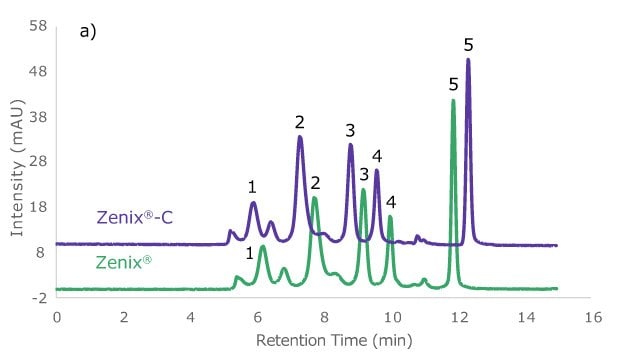
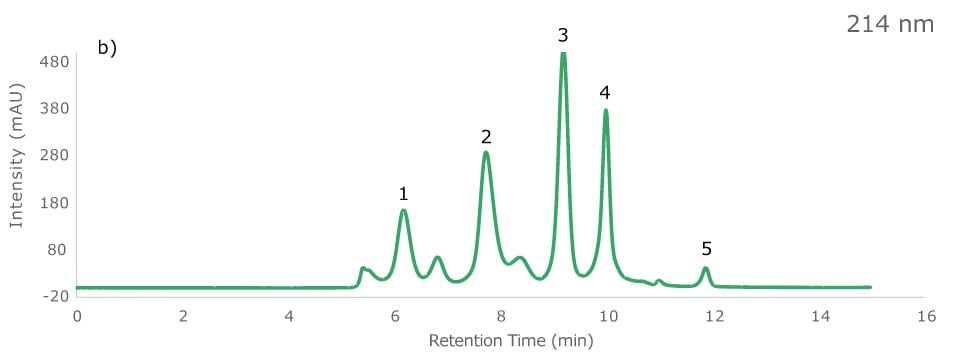
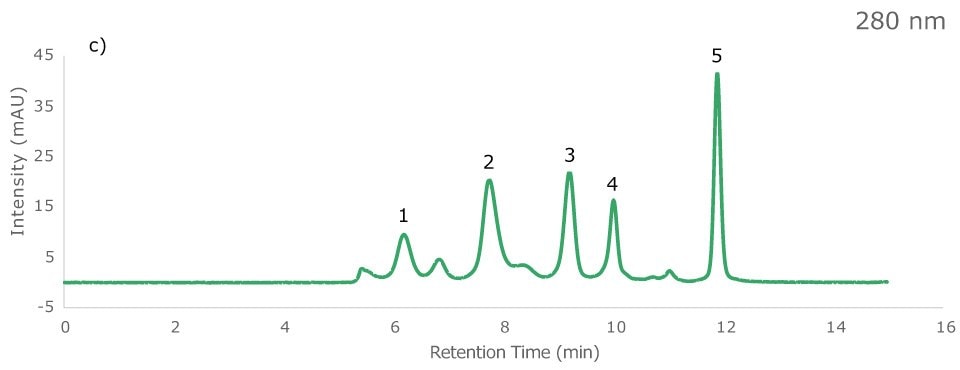
Figure 1.a) Chromatogram of the protein standard mix 15-600 kDa utilizing Zenix® (Green trace) and Zenix®-C (Purple trace) column by SEC-UV (280 nm); b) Chromatogram of protein standard sample on Zenix® column at 214 nm; c) Chromatogram of protein standard sample on Zenix® column at 280 nm. Peak assignment: 1 Thyroglobulin, 2 bovine γ-globulin, 3 chicken ovalbumin, 4 Ribonuclease A, 5 p-aminobenzoic acid (pABA).
UV detection wavelengths of 214 nm and 280 nm are commonly used for SEC analysis. In this protein standard mix, all components but pABA have higher molar absorptivity at 214 nm than at 280 nm (Figure 1b). Based on Beer’s Law, a peak response depends proportionally on the compound’s molar absorptivity at a certain wavelength. For pABA, its maximum molar absorptivity was at 280 nm, which corresponds to higher peak height at 280 nm than 214 nm (Figure 1c). For better observation, the protein mixture was viewed using a wavelength set at 280 nm as Figure 1a displays. 280 nm is more commonly used in purification analysis because the loading capacity can be increased. In this study, because of the high purity grade of the sample, the 214 nm detection and 10 µL injection volume scheme was selected.
SAMPLE TEST RESULTS – UNSTRESSED SAMPLE
150 mM phosphate buffer, pH 7.0, was used as mobile phase with at flow rate of 1.0 mL/min in an isocratic program to separate the mAbs and their aggregates. An amount of 10 µg of individual, unstressed sample was injected onto the column, and the separation was monitored at a wavelength of 214 nm. The SEC-UV chromatograms of an overlay of five different, unstressed mAbs (adalimumab, infliximab, MSQC16, MSQC18, and MSQC17) on Zenix® and Zenix®-C columns at 214 nm were compared in Figure 2 and Figure 3, respectively. For a better view of minor aggregates and fragments peaks, the zoomed-in chromatograms of both Zenix® and Zenix®-C columns are also displayed in Figure 2b and Figure 3b, respectively. The peaks eluted after 10 mins in the chromatogram are the formulation buffer and mobile phase buffer peaks. The detailed chromatographic data is listed in Table 6 and Table 7.
The performance of Zenix® and Zenix®-C column is comparable in the mAbs analysis shown in this work.
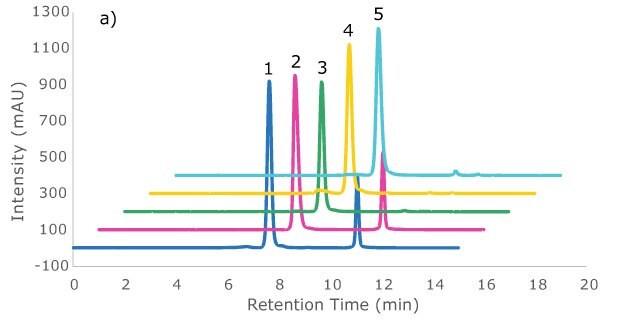
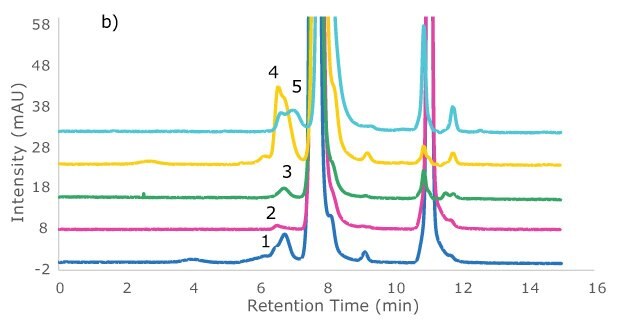
Figure 2.Overlay of five unstressed samples on Zenix® SEC-300, 30 cm x 7.8 mm I.D., at 214 nm wavelength, a) Full View; b) Zoom-in view. 1 Adalimumab, 2 Infliximab, 3 MSQC16, 4 MSQC18, 5 MSQC17
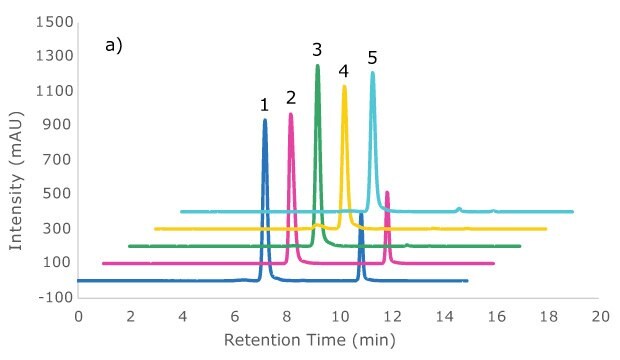
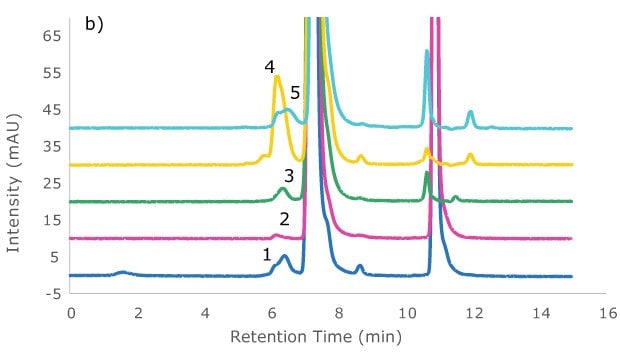
Figure 3.Overlay of all unstressed samples on Zenix®-C SEC-300, 30 cm x 7.8 mm I.D., at 214 nm wavelength, a) Full View; b) Zoom-in view. 1 Adalimumab, 2 Infliximab, 3 MSQC16, 4 MSQC18, 5 MSQC17
To improve the peak resolution, one strategy is to decrease the sample amount loaded onto the column while analyzing at a wavelength, analytes are more sensitive to. As the on-column loading decreased, the resolution between monomer and fragment (LMWs) peaks regions slightly increased, as shown in Figure 4. adalimumab was selected for this evaluation. The on-column loading amount was tested with 100 µg, 10 µg and 0.2 µg of sample. With decreased injection volume, the resolution and plate number for LMWs was improved as shown in Table 8.



Figure 4.Overlay of different injection amounts of Adalimumab onto Zenix® column at 214 nm. a). 2 µg injection, b). 10 µg injection, c). 100 µg injection. a and b were both injected at 10 µL while varying the concentration of Adalimumab; c was injected 100 µL
If the mAb is highly glycosylated or charged, there may be electrostatic interactions during the run. To alleviate this phenomenon, one can add additional sodium chloride to the elution buffer to help eliminate this interaction. With the additional of 300 mM NaCl (Figure 5) in the elution buffer, the resolution between the two HMWs was improved from 0.54 to 0.74.
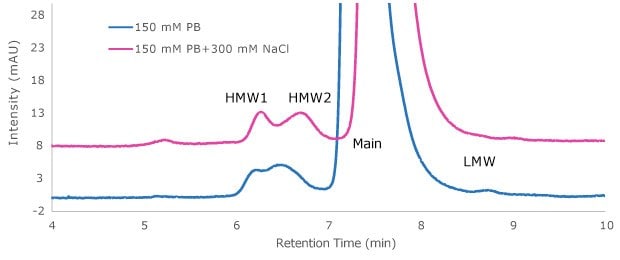
Figure 5.Overlay of MSQC17 on Zenix®-C column while varying additive salt concentrations
SAMPLE TEST RESULTS – STRESSED SAMPLE
Adalimumab sample was stressed by pH change from 6.0 to 1.0 to 10.0 and back to 6.0 and then incubated at 60 °C for 60 min. A volume of 100 µL of both unstressed and stressed adalimumab was injected onto an HPLC system to characterize the difference in HMWs percentage. Running condition was at 1.0 mL/min and 150 mM phosphate buffer, pH 7.0, as the mobile phase.
Figure 6 shows the chromatogram of the stressed (red trace) and unstressed adalimumab (blue trace). After the pH and temperature stress, the HMW aggregates area percentage was increased from 1.832% to 22.855% of the total area count while the main monomer peak dropped from 96.294% down to 69.510% (Table 10). With the pH and temperature stress, the adalimumab fragments increased as well, the percentage of total peak area counts increased from 1.545%, 0.328% to 3.819% and 3.815% as shown in Table 10.
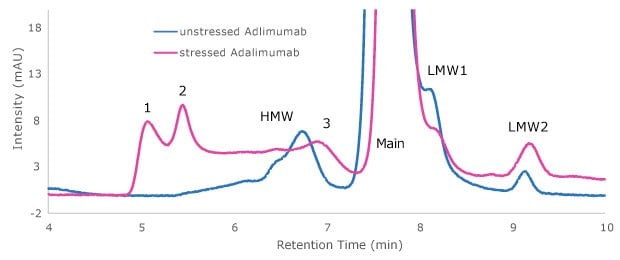
Figure 6.Comparison of chromatograms of unstressed adalimumab (blue trace) and stressed adalimumab (red trace) obtained on Zenix® column at wavelength 214 nm
CONCLUSION
This application note demonstrates the complete workflow for the characterization of mAb monomers, aggregates, and fragments using SEC-UV analysis. Zenix® and Zenix®-C SEC columns are capable to separate the variety of mAb’s monomers from their aggregates and fragments with sufficient resolution.
This workflow includes a system suitability test using a protein standard mix, unstressed mAbs and pH/temperature stressed mAbs. It describes the experimental practices including the detection wavelength selection (214 nm vs 280 nm), column maintenance tips, and SEC mobile phase and on-column injection amount optimization. In addition, the pH and temperature stressed adalimumab samples were also characterized utilizing a Zenix® SEC column showing the HMW formation increased in the stressed sample, interfering with the percentage of the monomer of the mAb peak.
This SEC-UV workflow can be suitable for the quantitative analysis of mAbs, with sufficient separation of mAb monomers from their aggregates and fragments.
To Place an Order or Receive Technical Assistance
In the U.S. and Canada, call toll-free 1(800)-645-5476
For other countries across Europe, call +44 (0) 115 943 0840
For other countries across Europe and the world, please click here.
For Technical Service, click here.
Materials
References
To continue reading please sign in or create an account.
Don't Have An Account?